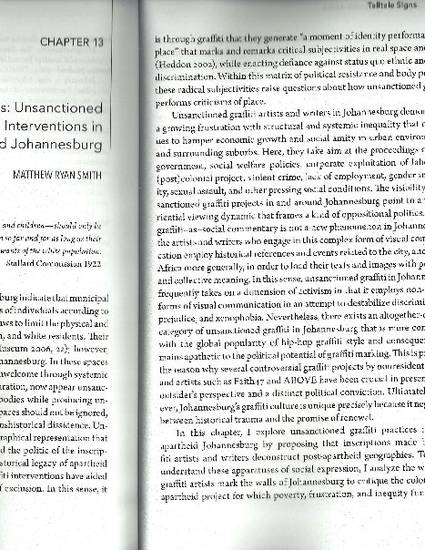
Contribution to Book
Tell-Tale Signs: Unsanctioned Graffiti Interventions in Post-Apartheid Johannesburg
Bronze Warriors and Plastic Presidents: Public Art in South Africa, 1999-2015
(2017)
Abstract
My chapter for the edited anthology Public Art in South Africa: 1999-2014 engages the much-neglected visual discourse of graffiti-as-public-art and its complex relationship to political discourse, historical trauma, and strategies of remembrance. While my chapter may loosely reference Cape Town and Durban, my case studies focus strictly on Johannesburg, where many of South Africa’s seminal street artists including Gogga, Mak1one, and Falko have worked and lived. I approach this chapter with a critical background in autobiographical studies, specifically autobiographical visual art, having written extensively on the rhetorics of affect, trauma, and memory. Thus, my research will be driven by the graffiti artist’s desire to punctuate urban spaces with ephemeral and transitory markings, criticism of corrupt political administrations, provocation of new ideas to shatter established ideology, and their offers of hope for the future. The desire for lower-class graffiti and street artists to speak out from a previously silenced position is an articulation that scholars such as bell hooks see as being largely political. Ultimately I am interested in answering how and why Johannesburg-based graffiti artists engage with apartheid, the reign of Thabo Mbeki, the death of Nelson Mandela, and the “born-free” generation of free-election voters. I intend for my chapter to be organized into four distinct sections: “Individual Pieces and Murals,” “Bombing and Tagging,” “Street Art” and “Indoor / Outdoor Exhibitions.” This categorizational strategy attempts to locate and define the prevailing modes of art-related graffiti and street art present in Johannesburg while comparing and contrasting how each constitutes a different working relationship to the political order and the urban environment. My critical methodology centres on scholars such as Gillian Whitlock and Anna Poletti who have written on the ways that social class serves as a strategy of self-expression and identification. Although street artists such as Banksy and interventionist tactics such as his are slowly gaining acceptance in the art community and with the public, “tagging”—a signatory marking of territory / identity in public spaces—have remained “resistant to this recent wave of respectability.” Most communities view tagging as egotistical, pollutive, or vandalistic, whereas I will position tagging, and much street art in Johannesburg in general, as a strategy of expression affiliated with historical trauma. Leigh Gilmore has elucidated concerns such as these while admitting that there is much to ascertain in traumatic self-narratives: to “read and learn about [other people]… you will learn more about history and, perhaps, yourself and what you are capable of.”
Disciplines
Publication Date
2017
Editor
Brenda Schmahmann and Kim Miller
Publisher
Indiana University Press
Citation Information
Matthew Ryan Smith, Ph.D.. "Tell-Tale Signs: Unsanctioned Graffiti Interventions in Post-Apartheid Johannesburg" BloomingtonBronze Warriors and Plastic Presidents: Public Art in South Africa, 1999-2015 (2017) Available at: http://works.bepress.com/matthewryansmith/92/
